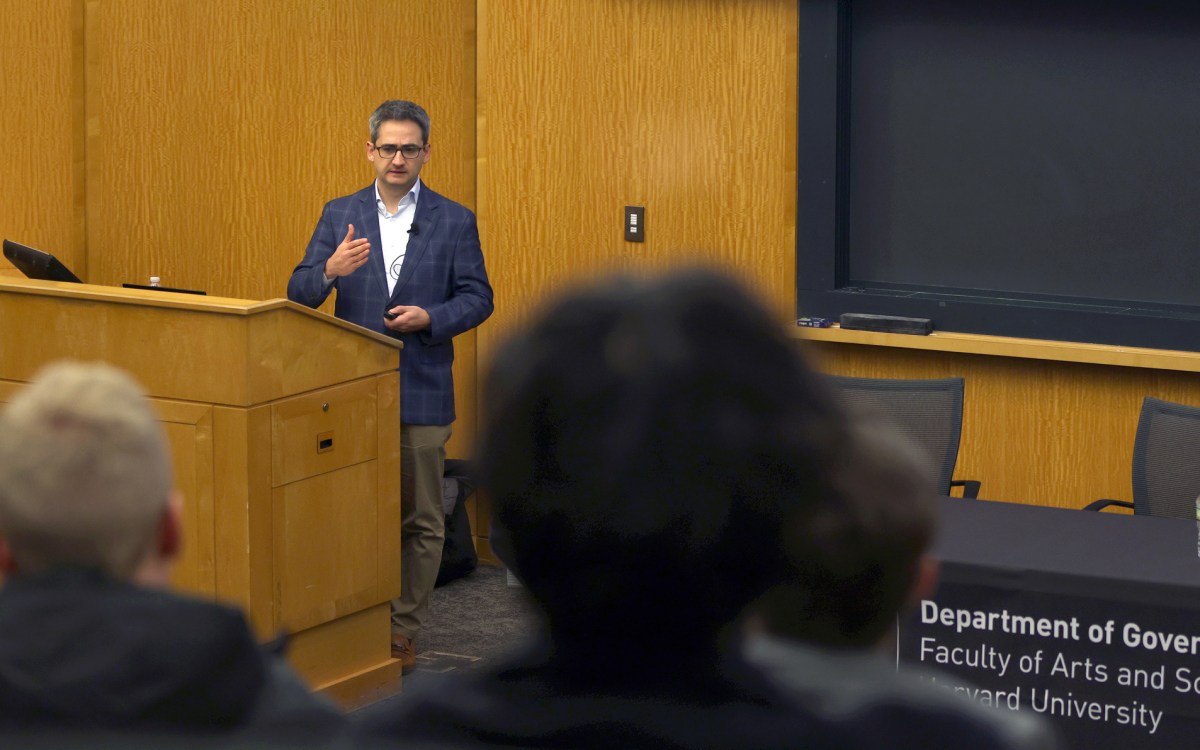Regulators put cryptocurrency in crosshairs
Business School professor offers look at landscape and challenges for industry, government

HBS economist Scott Duke Kominers explains the explosive growth of cryptocurrency and why U.S. regulators now appear poised to swoop in.
Rose Lincoln/Harvard Staff Photographer
Is cryptocurrency the future of global banking and trade, or a sketchy payment and investment vehicle favored by scammers and speculators, criminal organizations, and any individual or entity shut out of Western banking systems, like North Korea?
The jury is still out. One thing that is clear, however, is that the cryptocurrency market continues to grow as its popularity has become more mainstream since 2019. Even many once-skeptical institutional investors have come around after seeing some of the mind-boggling returns. In January 2019, one Bitcoin traded for $3,441; this week, it hit $43,136.
But that success may have a price. Calls to rein in the industry are at fever pitch. This month China, one of the world’s largest digital currency markets, outlawed all crypto-related transactions. It banned trading them in 2019. The U.S. Treasury said this week it will sanction a cryptocurrency exchange for the first time for facilitating ransomware payments. New tax and trading rules for the industry are included in legislation Congress is scheduled to vote on by week’s end. And the U.S. Securities and Exchange Commission is also pushing for greater enforcement. SEC Chairman Gary Gensler called cryptocurrency an asset class “rife with fraud, scams, and abuse” and said investors don’t have enough regulatory protection from the swarms jumping into crypto finance, issuance, trading, and lending.
Scott Duke Kominers ’09, A.M. ’10, Ph.D. ’11, is the MBA Class of 1960 Associate Professor of Business Administration at Harvard Business School and a faculty affiliate of Harvard’s Department of Economics and the Harvard Center of Mathematical Sciences and Applications. He advises crypto businesses and projects, including Facebook’s digital wallet and payment system, and holds crypto currency and other crypto assets. Interview has been edited for clarity and length.
Q&A
Scott Duke Kominers
GAZETTE: There are thousands of different cryptocurrencies, but no consensus on the precise number. The range is between 5,000 and 12,000, valued at about $2 trillion. What does the landscape look like today?
KOMINERS: Those numbers sound huge, but there are actually many, many more than that because lots of crypto products are not currencies and lots of cryptocurrencies are too small to be part of mainstream exchanges. Many crypto products are effectively just tokens. Sometimes these are representative of ownership in decentralized autonomous organizations, which are organizations that share governance rights and returns to a committee of participants by allocating them tokens — a bit like stock shares. There are project-specific tokens used in specific online games or among individual communities. There are NFTs, which are unique non-fungible tokens that have been used as representing ownership over things like digital artworks. Tons of these are being minted daily at this point. So, there is a very large landscape. The pure currency aspect of it is a huge market on its own, but a drop in the bucket of the total applications of crypto and blockchain technology today.
GAZETTE: What’s the appeal for investors? Is it just the eye-popping returns or is there more to it?
KOMINERS: Some people have gotten interested in cryptocurrency because of the investment returns, unquestionably. But there are also real, practical infrastructure and technology benefits. You’re starting to see countries willing to receive officially recognized crypto payments. And people have been considering whether crypto technology can be used to deliver government aid. This is because when it’s working, crypto is frictionless, and thus creates a much more efficient way of transferring and sharing value among people. And, as a result, there’s a real opportunity to use crypto for large-scale payments, as well as in things like small business payment processing. Also, there’s a big opportunity for enhancing financial inclusion, by providing secure payment networks and cross-border transfers in places that don’t otherwise have well-structured consumer financial systems. So, while some people are interested in this for the short- or medium-term investment opportunity, I think a lot of the investment we’ve seen flow in on the institutional and venture sides is because there are real, valuable technologies that are being built on crypto backbones that can do things we never could do before in markets.
GAZETTE: The SEC chairman called this an asset class “rife with fraud, scams, and abuse.” Is this industry operating in a rule-free, “Wild West” atmosphere, as he suggested?
KOMINERS: I haven’t read the full Gensler remarks, so I can’t comment explicitly on his overall take, but I can comment on some of the individual elements you mention. It’s clear that this space needs much more consumer protection, and we’re starting to see that. Right now, if a hacker gains access to your crypto wallet, they can drain it and you may have no recourse. But the newer waves of wallet technologies and crypto exchanges are thinking hard about all the things consumers expect out of banking products and equities trading accounts. They’re trying to create more security and protections at the consumer-interface level. And then, of course, you also need regulation to prevent financial crime and scams, just like we have in other parts of the financial-services industry.
GAZETTE: Some lawmakers have pointed to the GameStop stock trading frenzy in early 2021 as analogous to the crypto market, saying that most ordinary investors have gotten caught up in hype and don’t fully understand the risks they’re taking.
“I think a lot of the investment we’ve seen flow in on the institutional and venture sides is because there are real, valuable technologies that are being built on crypto backbones that can do things we never could do before in markets.”
KOMINERS: First of all, it’s important to note that the GameStop run-up wasn’t in a new trading arena — it was Internet-hyped trading of a specific stock in the regular stock market. That said, the GameStop story is in some sense analogous to the meme trading of crypto products like Dogecoin — there’s consumer confusion around the idea that these assets could lose value. A lot of people lost a lot of money in the GameStop and Dogecoin run-ups and crashes. They were on a platform that made trading feel like a video game, and didn’t understand the real risks. And so in those ways, it’s analogous. Consumers and investors need to understand that these are high variance, speculative assets.
But when you get to the technology infrastructure pieces, GameStop and crypto can look very different. Cryptocurrency trading now looks a lot like equities trading — you have a brokerage account at an exchange, or potentially on a platform like Robinhood. But for many of the other crypto applications, the infrastructure is very, very new, and the platforms are very, very new, and they’re not heavily protected.
I think we’ll see more regulation around messaging and communication, but there are also more structural questions. For example, one of the regulatory conversations is around stablecoins — crypto assets that hold nominally fixed values because they’re designed to just be used for moving money from one place to another in a fixed denomination. They’re typically backed by reserves in a way similar to how banks back their loans with deposits. But there are questions about how to properly structure those reserves. If everyone simultaneously decided they wanted to divest, will stablecoins have the reserves to support that? I expect to see regulation around allowable assets and reserve design — just like we have with banks.
And finally, we’ll need regulation to ensure open competition among different crypto products and platforms.
GAZETTE: Besides fending off regulations, what are the industry’s other challenges?
KOMINERS: One basic challenge is around taxation of crypto income. This isn’t just about tax avoidance concerns — a lot of people would like to pay taxes on their crypto but have absolutely no idea how to do so. We don’t have clear crypto categories for taxation purposes, so it’s extremely complicated to figure out which parts are ordinary income versus capital gains, as well as when the associated income has accrued. Organizing the tax treatment of all these assets — and then, of course, ensuring tax payment — is essential.
Another challenge is environmental: A lot of the most popular crypto technologies at the moment require tremendous amounts of energy to run. And so, we’re going to start seeing government leadership and regulation driving a shift toward versions of this technology that are more environmentally sustainable.
Bitcoin and other early blockchains use a technology where you have to prove that you solved a very hard computational problem to record transactions securely. And solving those computational problems is taking up absurd amounts of energy. Newer blockchains use much less energy-intensive ways of validating transactions. And so, my guess and hope is that the way we’re going to get away from environmentally harmful cryptocurrency transactions is through continual improvements in the technology, alongside regulation and market forces pushing toward technologies that are much more efficient.
GAZETTE: If new regulations are on the way, what would be the best- or worst-case scenarios for the industry?
KOMINERS: I don’t think it’s a question of ‘no regulation’ versus ‘a lot.’ The real question is the extent to which regulators understand that crypto is a different type of product and tech infrastructure from anything they’ve regulated before. The worst case would be to just treat it like historical financial products or like historical tech platforms without thinking about the ways in which crypto differs, both in terms of its use cases and in terms of its underlying technology.







